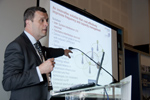|
“Anyone who runs a network will tell you that your biggest cost is out there in the networking sites”, he continues. “And it’s driven by three things: it’s driven by the transmission link, it’s driven by rental and it’s driven by power. How much power it takes to power these things up? On their own, not very big. But if you run 4000 sites, you get to a very big number very quickly.” Running through the concept with a series of diagrams, he explains that TETRA service is generally provided through base stations, supplemented by cell-enhancers, which relay coverage into buildings, tunnels and underground areas. Cell-enhancers are simpler and cheaper than base stations, and do not require costly backhaul links. But they cannot normally be used for wide-area coverage above ground because, operating on the same frequencies as the parent base station, they would interfere with it. In the solution implemented by Airwave, the outlying sites are replaced by cell-enhancers – but the timings of the signals are modified so that they arrive in sync. This avoids the inter-symbol interference which would otherwise make digital reception impossible. “I’ve still got my site in the middle and you’ll notice that is still fed by a ground-based network”, Mr Evans continues, referring to his diagram. “But you will notice that my four adjacent sites have now lost their connection and they’ve become enhancers. They are all using the same frequency and there is no inter-symbol interference. “And we do that by courtesy of some technology developed by Axell Wireless which allows us to synchronize those signals coming in. The terminal now no longer cares that it can see two signals from different places, because it thinks they are one signal, because the timing difference is not that great. So now I’ve gone from a position of having interference to having no interference. “I’ve now got a solution that has taken my ground-based network away; I’ve now got a solution that reuses the frequency on my adjacent sites, so I don’t have to reuse separate frequencies everywhere; and I’ve got a solution where the kit on that site will cost me a lot less to buy than a traditional base station.” Releasing resourcesBut the scheme offers further economies and enhancements for operators. “Clearly you still need to have base stations in the normal way. But now, because I’ve got rid of four of my transmission links, I could use one of those I’ve got rid of and put dual transmission resilience on that central site to make it an even higher-availability site. And I’m still saving myself three links.” Other equipment saved could be re-purposed to add resilience to the base station components themselves. And, having released all the frequencies used by the surrounding sites in the new super-cell, the network operator could even use them to multiply the traffic capacity, by overlaying further super-cells. “So what’s the catch?”, Mr Evans asks himself. He cautions that you need to understand the usage profile of the area to be served – but otherwise, it seems that there isn’t a catch. “This is for real”, he says. “It’s a proof of concept that we’ve run in the UK already. It’s based on single-channel equipment from Axell – and, by the way, we are developing a roadmap between us to look at other capabilities in the future in terms of power levels, number of channels, et cetera.” There’s one further benefit, he adds. A typical base station consumes some 600–640 watts, but a cell enhancer draws just 180 watts – a substantial saving in power. “Simple maths here”, he says. “You have a choice. You can either keep the number of batteries that you have already on your standby power but substantially increase your standby time, because you don’t need as many batteries now. Or you can keep the same level of standby power but take a lot of your batteries out because you no longer need them.” (中国集群通信网 | 责任编辑:陈晓亮) |

 Let me just start by saying that today I intend to be extremely disruptive”, warns Euros Evans, chief technology officer for Airwave Solutions, operator of the national public safety
Let me just start by saying that today I intend to be extremely disruptive”, warns Euros Evans, chief technology officer for Airwave Solutions, operator of the national public safety